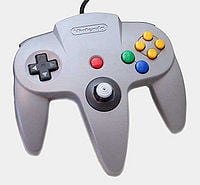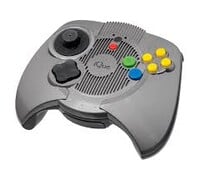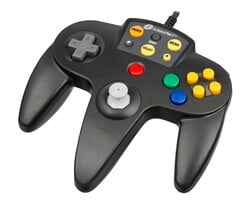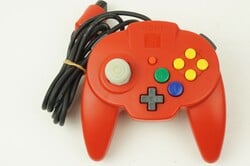Nintendo 64 controller
The Nintendo 64 controller is the default controller for the Nintendo 64. It is used to play Super Smash Bros. The controller has a unique three pronged M-shape, as Nintendo did not know if the use of analog sticks would become widespread and covered their bases by making the controller comfortable to hold in multiple ways. A majority of the Nintendo 64's games require players to grip their left hand on the middle handle and their right hand on the right handle, including Super Smash Bros. Some games, however, did allow players to hold the controller's left and right prongs to control the game, such as Dr. Mario 64 and Kirby 64: The Crystal Shards. The third option is to hold the left handle with the left hand and the middle handle with the right hand, though few games used this method; it was used in the Ekans Hoop Hurl minigame in Pokémon Stadium, and Sin and Punishment, as an alternate control method via the settings menu.
Compatibility[edit]
The Nintendo 64 controller is officially only compatible with the original Super Smash Bros. due to its proprietary hardware that has never been made forwards compatible with any future system. Adapters exist to plug an N64 controller into a GameCube controller port, but this method is unofficial.
The Nintendo Switch Online N64 controller is technically compatible with Super Smash Bros. Ultimate due to having the internal components of a Pro Controller, though this method is not intended and can lead to awkwardness with button placement. Rumble is not supported.
Standard controls[edit]
Super Smash Bros.[edit]
| Move | |
| Standard attacks | |
| Special moves | |
| Jump | |
| Shield | |
| Grab | |
| Taunt | |
| Pause | |
| Move (menu only) |
Super Smash Bros. Ultimate[edit]
Note: Only applies to the wireless N64 controller. Does not include additional buttons added to that specific model. All buttons listed are mappable.
| Control | Nintendo Switch reads as | Action |
|---|---|---|
| L |
Move | |
| Standard attacks | ||
| Special moves | ||
| R |
Smash attacks | |
| Grab | ||
| Shield | ||
| Pause | ||
| Taunts |
Technical data[edit]
Input lag[edit]
The controller has among the lowest latency out of Nintendo's controllers with minimal variance, being as low as 48ms (2.8 frames) and as high as 66.4ms (almost 4 frames).[1]
Control Stick[edit]
The analog Control Stick uses an optical sensor mechanism. Each axis has a rotating wheel which has small holes along their circumference, allowing light to pass through them to be picked up by a photodiode on the other side, with values ranging from -128 to 127, though its effective range is limited by the stick's physical octagonal gate. Due to variance in controllers and the degrading of the stick's quality over time, Nintendo recommended developers to set their maximum values as 61 for the X-axis and 63 for the Y-axis. The stick's neutral position is set at power on, though it can be recalibrated by pressing the L, R, and Start buttons at the same time.[2][3][4]
Add-ons[edit]
Rumble Pak[edit]
Released in 1997 and plugs into the back port of the controller. Originally bundled with Star Fox 64 and vibrates under certain circumstances with compatible games to increase immersion. Super Smash Bros. is also compatible.
Controller Pak[edit]
Released in 1998 and plugs into the back port of the controller. Saves data onto itself, which allows players to take their save data with them even without the original cartridge present.
Transfer Pak[edit]
Released in 1998 and plugs into the back port of the controller. Allows certain Nintendo 64 games to interact with certain Game Boy games when one is inserted into the pak.
Licensed variants[edit]
iQue Player[edit]
Released in 2003 exclusively in China, the iQue Player is a plug & play variant of the Nintendo 64 for where the controller connects directly to a tv. The console was developed by iQue ltd, a joint venture between Nintendo and Wei Yen created to exploit a loophole in China's banning of foreign video game products and curb rampant piracy in the region. Game production for the system stopped in 2006, and support was discontinued in 2016. Other iQue systems based on the Game Boy Advance, Nintendo DS, and Nintendo 3DS also released, though support for all systems were very limited due to the brand failing to catch on in its target market, and the systems never released outside of China. Super Smash Bros. released for the iQue Player in 2005, as it had already been translated into simplified Chinese.
The controller itself is reminiscent of the GameCube controller, as both were being created about the same time. The prongs were removed and more surface area was added, with the control stick being moved to the left side and the D-pad directly underneath. The Z button is also moved to underneath the L button and a unique power button is placed above the start button. The controller has an AV and USB port to plug into both a television set and computer, as well as an AC adapter port. The bottom of the controller contains a slot meant to hold memory cards that can hold data obtained from special kiosks that download games. A multitap device was also made so up to three additional controllers can be plugged in for multiplayer modes.
LodgeNet controller[edit]
A licensed Nintendo 64 controller by LodgeNet was used as part of the Nintendo Gateway System. This controller was manufactured by Hori and used only in hotels and similar services to play Nintendo 64 games with an hourly fee.[5][6]
All releases of the LodgeNet controller feature additional buttons for ordering room service at the lodging, among other things, otherwise the controller is identical to the standard controller. However, later releases of the LodgeNet controller feature an improved, modernized joystick akin to the GameCube's joystick, albiet with a plastic grip. These joysticks are generally preferable due to the wear down issues of the original joystick, as well as generally making games easier to control, and thus leading to a highly sought-after, official means of using a standard Nintendo 64 controller with a more flexible and durable joystick.[7]
However, LodgeNet controllers, by default, are incompatible with the Nintendo 64 console, as they use a landline connector as opposed to a standard Nintendo 64 port.[8] Converters, such as an official one used by LodgeNet, are necessary for use on a standard-issue Nintendo 64. Otherwise, external modification is necessary, which negatively affects potential resale value. Regardless, the familiar layout and official nature of this controller, gives it some prestige among more traditional players, as well as collectors. In particular, the later model with the revised joysticks are considered valuable, due to featuring an official joystick of higher quality improving the longevity of the controllers.
Hori Mini Pad[edit]
Released in 2000 by 3rd party hardware manufacturer Hori. Contains all the buttons of a standard Nintendo 64 controller, but rearranged so every button can be accessed with two hands.
Nintendo Switch Online controller[edit]
Released in October 2021 by Nintendo. This controller is technically not a Nintendo 64 controller, but rather a Nintendo Switch Pro Controller designed like one. This "Nintendo 64 Controller" has all the typical buttons, but with an added ZR button, Capture button, Home button, Sync button, built-in rumble and a USB-C connector in place of the cord. The C buttons act as digital inputs for the right control stick, allowing for smash attack buttons. They can be mapped to jump like the original controller in the Controls menu. Being effectively a Switch Pro Controller, it is unofficially compatible with all games that support that controller. However, some games may not function well with the Nintendo 64 controller due to having less buttons than required for gameplay purposes, and only the collection of Nintendo 64 games included as part of the Nintendo Switch Online Expansion Pack, as well as the version of Super Mario 64 in Super Mario 3D All-Stars following an update, detect it as a Nintendo 64 controller and map buttons accordingly.
In competitive play[edit]
In the earliest days of the franchise and its competitive scene, the official Nintendo 64 controller was the tournament standard. This was due to no preferable alternatives being available at the time and the console requiring a controller that fits the proprietary Nintendo 64 controller port. Due to being incompatible with Nintendo's next console, the GameCube, the N64 controller only continued to see frequent use at Smash 64 tournaments. After the rise of preferable alternatives like the Hori Mini Pad and emulators removing the restrictions imposed by official hardware, official controllers have generally fallen out of favor at top level play. While not necessarily an uncommon sight at tournaments, most of the best Smash 64 players in the world have officially retired the controller in favor of something else.
The wireless N64 controller compatible with Nintendo Switch similarly are a rarity in Ultimate tournaments due to the plethora of preferable alternatives and the limited stock exclusive to customers with an active Nintendo Switch Online subscription.
Gallery[edit]
References[edit]
- ^ Smash Controller Latency Article
- ^ Nintendo 64 Developer Manual - Controller programming precautions
- ^ N64 Squid - Does the N64 joystick really allow 360 degrees of control?
- ^ Technical article on N64brew Wiki
- ^ Nintendo Gateway System Wikipedia Page
- ^ LodgeNet on MarioWiki
- ^ LodgeNet Controller Comparison
- ^ LodgeNet Controller information, shows port
| Controllers and buttons | |
|---|---|
| Nintendo 64 controller | |
| Nintendo GameCube controller | |
| Wii Remote (and Nunchuk) | |
| Classic Controller | L |
| Nintendo 3DS | |
| Wii U GamePad / Wii U Pro Controller | L |
| Joy-Con / Joy-Con 2 | |
| Nintendo Switch Pro Controller / Nintendo Switch 2 Pro Controller | L |
| Third-party controllers | Hori Mini Pad · Arcade controller · Keyboard |
| Other | Smash Controller · Controller modification |






